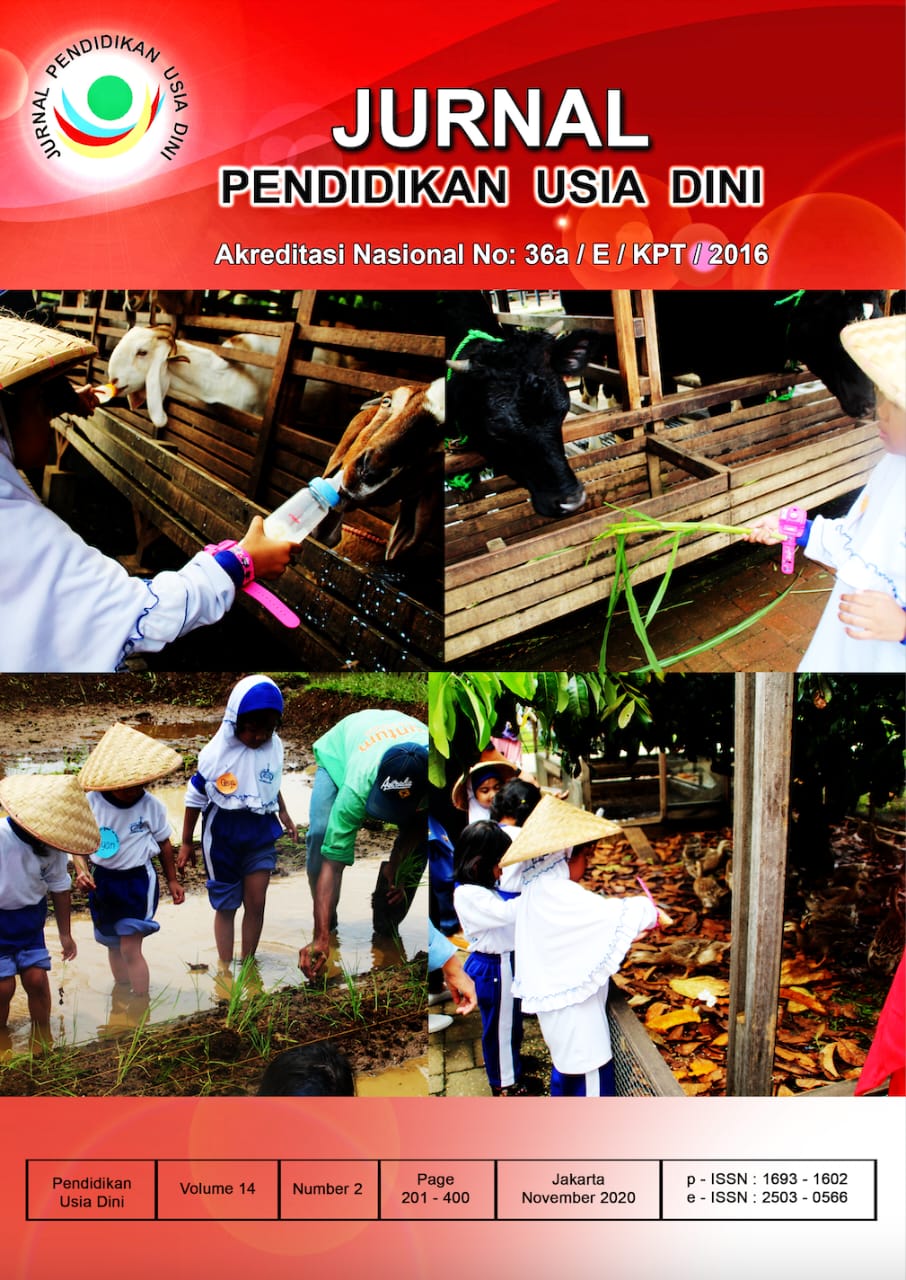Understanding Parental Health Literacy for Clean and Healthy Behavior in Early Childhood During the Covid-19 Pandemic
DOI:
https://doi.org/10.21009/JPUD.142.13Abstract
In the COVID-19 pandemic scenario, parents need to be familiar with health literacy by applying clean and healthy living habits to their family members, especially those with early childhood. This study aims to explain parents' perceptions of health literacy for a clean and healthy behavior in their children during the COVID-19 pandemic. The method used in this study is a cross-sectional study involving 22 men and 62 female respondents. Respondent requirements were used in data analysis to determine parents' perceptions of health literacy and the efforts they have made to practice clean and healthy lifestyle in their children. The research findings show that knowing the health awareness of parents has an impact on a child's balanced lifestyle. Based on six measures of clean and healthy behavior for children, three indicators were determined in the category of discipline and high discipline: using clean water, using the toilet, and doing physical activity. The act of washing children's hands with soap indicators has a high discipline score and the use of masks in children has low discipline. If the use of masks is not disciplined by parents, exposure to COVID-19 in early childhood can be disrupted.
Keywords: Early Childhood, Parental health literacy, Clean and healthy behaviors
References:
Abuhammad, S. (2021). Parents’ knowledge and attitude towards COVID‐19 in children: A Jordanian Study. International Journal of Clinical Practice, 75(2). https://doi.org/10.1111/ijcp.13671
Bauza, V., Sclar, G. D., Bisoyi, A., Majorin, F., Ghugey, A., & Clasen, T. (2021). Water, sanitation, and hygiene practices and challenges during the COVID-19 pandemic: A cross-sectional study in rural Odisha, India [Preprint]. Epidemiology. https://doi.org/10.1101/2021.01.26.21250274
Berkman, N. D., Sheridan, S. L., Donahue, K. E., Halpern, D. J., & Crotty, K. (2011). Low Health Literacy and Health Outcomes: An Updated Systematic Review. Annals of Internal Medicine, 155(2), 97. https://doi.org/10.7326/0003-4819-155-2-201107190-00005
Bröder, J., Okan, O., Bauer, U., Schlupp, S., & Pinheiro, P. (2020). Advancing perspectives on health literacy in childhood and youth. Health Promotion International, 35(3), 575–585. https://doi.org/10.1093/heapro/daz041
Center for Disease ontrol and Prevention (CDC). (2019). How to Protect Yourself and Others. https://www.cdc.gov/
Chanchlani, N., Buchanan, F., & Gill, P. J. (2020). Addressing the indirect effects of COVID-19 on the health of children and young people. Canadian Medical Association Journal, 192(32), E921–E927. https://doi.org/10.1503/cmaj.201008
Clouston, S. A. P., Manganello, J. A., & Richards, M. (2016). A life course approach to health literacy: The role of gender, educational attainment and lifetime cognitive capability. Age and Ageing, ageing; afw229v1. https://doi.org/10.1093/ageing/afw229
Cooper, A. (2019). Health in the eyes of young people. The Lancet Child & Adolescent Health, 3(5), 299. https://doi.org/10.1016/S2352-4642(19)30085-9
Duplaga, M. (2020). Determinants and Consequences of Limited Health Literacy in Polish Society. International Journal of Environmental Research and Public Health, 17(2), 642. https://doi.org/10.3390/ijerph17020642
Duplaga, M., & Grysztar, M. (2021). The Association between Future Anxiety, Health Literacy and the Perception of the COVID-19 Pandemic: A Cross-Sectional Study. Healthcare, 9(1), 43. https://doi.org/10.3390/healthcare9010043
Gagliardi, A. R., Berta, W., Kothari, A., Boyko, J., & Urquhart, R. (2015). Integrated knowledge translation (IKT) in health care: A scoping review. Implementation Science, 11(1), 38. https://doi.org/10.1186/s13012-016-0399-1
Humphrys, E., Burt, J., Rubin, G., Emery, J. D., & Walter, F. M. (2019). The influence of health literacy on the timely diagnosis of symptomatic cancer: A systematic review. European Journal of Cancer Care, 28(1), e12920. https://doi.org/10.1111/ecc.12920
Kementerian Kesehatan RI. (2011). Pedoman Pembinaan Perilaku Hidup Bersih dan Sehat (PHBS). Kementerian Kesehatan RI.
Lee, P.-I., Hu, Y.-L., Chen, P.-Y., Huang, Y.-C., & Hsueh, P.-R. (2020). Are children less susceptible to COVID-19? Journal of Microbiology, Immunology and Infection, 53(3), 371–372. https://doi.org/10.1016/j.jmii.2020.02.011
Nutbeam, D. (1998). Health promotion glossary. 13(4), 16. https://doi.org/10.1093/heapro/13.4.349
O’Conor, R., Muellers, K., Arvanitis, M., Vicencio, D. P., Wolf, M. S., Wisnivesky, J. P., & Federman, A. D. (2019). Effects of health literacy and cognitive abilities on COPD self-management behaviors: A prospective cohort study. Respiratory Medicine, 160, 105630. https://doi.org/10.1016/j.rmed.2019.02.006
Okan, O. (2019). The importance of early childhood in addressing equity and health literacy development in the life-course. 5(2), 8.
Sentell, T., Vamos, S., & Okan, O. (2020). Interdisciplinary Perspectives on Health Literacy Research Around the World: More Important Than Ever in a Time of COVID-19. International Journal of Environmental Research and Public Health, 17(9), 3010. https://doi.org/10.3390/ijerph17093010
Sørensen, K., Pelikan, J. M., Röthlin, F., Ganahl, K., Slonska, Z., Doyle, G., Fullam, J., Kondilis, B., Agrafiotis, D., Uiters, E., Falcon, M., Mensing, M., Tchamov, K., Broucke, S. van den, & Brand, H. (2015). Health literacy in Europe: Comparative results of the European health literacy survey (HLS-EU). The European Journal of Public Health, 25(6), 1053–1058. https://doi.org/10.1093/eurpub/ckv043
Sørensen, K., Van den Broucke, S., Pelikan, J. M., Fullam, J., Doyle, G., Slonska, Z., Kondilis, B., Stoffels, V., Osborne, R. H., & Brand, H. (2013). Measuring health literacy in populations: Illuminating the design and development process of the European Health Literacy Survey Questionnaire (HLS-EU-Q). BMC Public Health, 13(1), 948. https://doi.org/10.1186/1471-2458-13-948
Toussaint, L. L., Cheadle, A. D., Fox, J., & Williams, D. R. (2020). Clean and Contain: Initial Development of a Measure of Infection Prevention Behaviors During the COVID-19 Pandemic. Annals of Behavioral Medicine, 54(9), 619–625. https://doi.org/10.1093/abm/kaaa064
Wang, C., Pan, R., Wan, X., Tan, Y., Xu, L., McIntyre, R. S., Choo, F. N., Tran, B., Ho, R., Sharma, V. K., & Ho, C. (2020). A longitudinal study on the mental health of general population during the COVID-19 epidemic in China. Brain, Behavior, and Immunity, 87, 40–48. https://doi.org/10.1016/j.bbi.2020.04.028
Weston, D., Hauck, K., & Amlôt, R. (2018). Infection prevention behaviour and infectious disease modelling: A review of the literature and recommendations for the future. BMC Public Health, 18(1), 336. https://doi.org/10.1186/s12889-018-5223-1
Zaben, K., & Khalil, A. (2019). Health Literacy, Self-Care Behavior and Quality of Life in Acute Coronary Syndrome Patients: An Integrative Review. Open Journal of Nursing, 09(04), 383–395. https://doi.org/10.4236/ojn.2019.94035
Downloads
Published
How to Cite
Issue
Section
License
JURNAL PENDIDIKAN USIA DINI work is licensed under a Creative Commons Attribution 4.0 International License. (http://creativecommons.org/licenses/by/4.0/)





